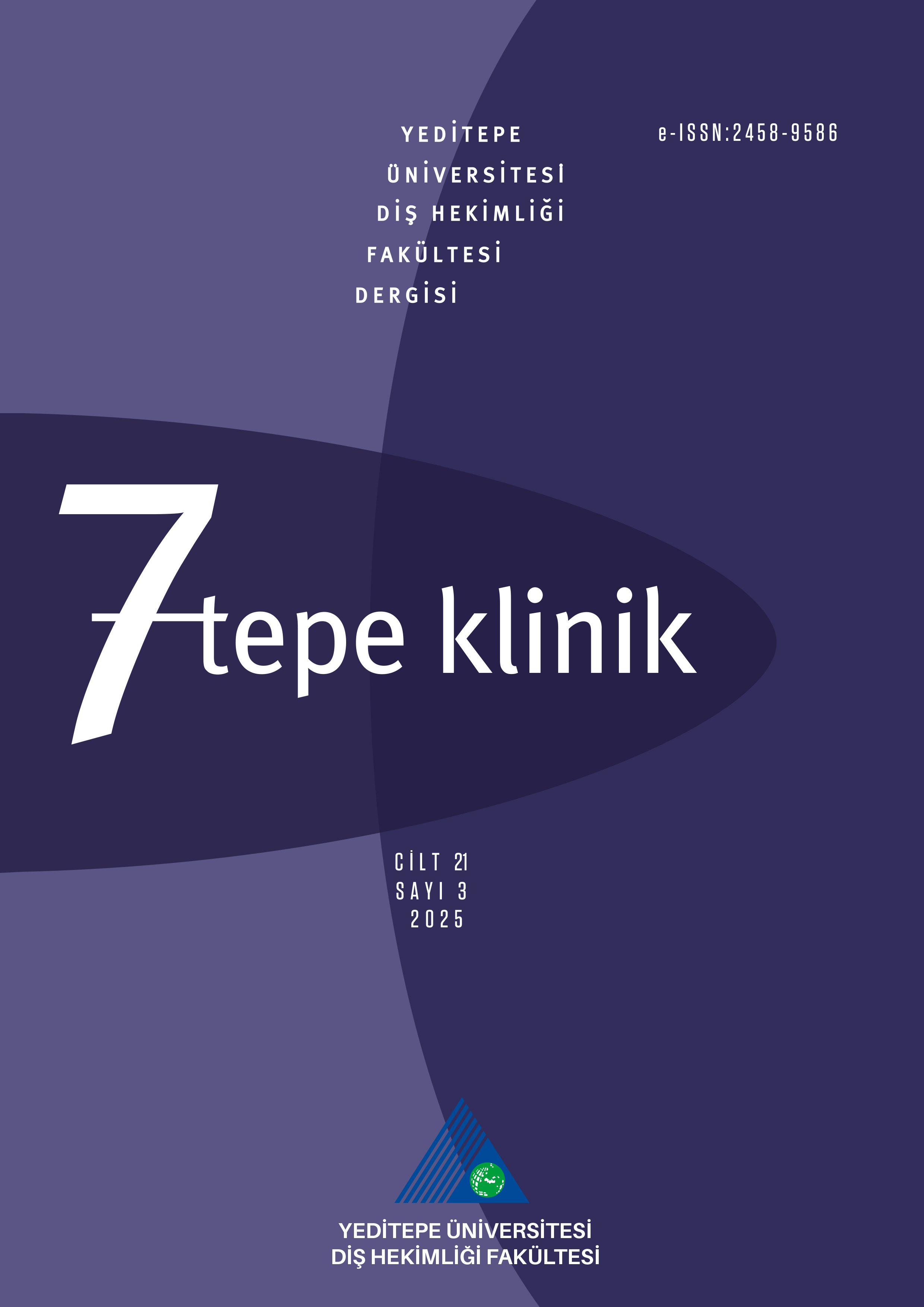Farklı enstrümentasyon sistemleri kullanılarak yapılan kök kanal preparasyonu sırasında apikalden taşan debris miktarının değerlendirilmesi
Recai Zan1, Hüseyin Sinan Topçuoğlu2, İhsan Hubbezoğlu3, Jale Tanalp4, Meriç Karapınar Kazandağ41Cumhuriyet University, Faculty of Dentistry, Department of Endodontics, Sivas2Erciyes University, Faculty of Dentistry, Department of Endodontics, Kayseri
3Cumhuriyet University, Faculty of Dentistry, Department of Restorative Dentistry, Sivas
4Yeditepe University, Faculty of Dentistry, Department of Endodontics, Istanbul
Amaç: Bu çalışmanın amacı, Protaper Gold (PTG; Dentsply Maillefer, Ballaigues, Switzerland), WaveOne Gold (WOG; Dentsply Maillefer), One Shape New Generation (OSNG; MicroMega, Besancon, France), Twisted File Adaptive (TFA; SybronEndo, Orange, CA, USA), and K3XF (SybronEndo) nikel-titanyum enstrümantasyon sistemleri ile preparasyon boyunca apikalden taşan debris miktarını araştırmaktır.
Gereç ve Yöntem: Yetmiş beş insan tek köklü mandibular premolar diş rastgele olarak 5 gruba ayrılmıştır (n=15). Kök kanalları PTG, WOG, OSNG, TFA, ve K3XF eğeleri kullanılarak üreticinin talimatlarına göre prepare edilmiştir. Enstrümantasyon boyunca apikalden taşan debris önceden tartılmış ependorf tüplerin içinde toplanmıştır. Ependorf tüpler daha sonra 5 gün boyunca 70°Cde bir inkübatör içerisinde muhafaza edilmiştir. Tüpler yeniden tartıldı ve ilk ve son ağırlıkları arasındaki fark hesaplanmıştır. Veriler istatistiksel olarak tek yönlü ANOVA ve Tukey post-hoc testleri kullanılarak analiz edilmiştir.
Bulgular: TFA grubu diğer tüm gruplar ile karşılaştırıldığında önemli ölçüde daha fazla debris taşırmıştır (P<0,05). İstatistiksel olarak, K3XF ve OSNG grupları, WOG ve FTG gruplar ile karşılaştırıldığında daha fazla debris taşması ile ilişkili bulunmuştur (P<0,05). K3XF ve OSNG gruplar arasında istatistiksel olarak anlamlı bir fark saptanmamıştır (P>0,05). Buna ek olarak, WOG ve FTG grupları arasında apikalden taşan debris miktarında istatistiksel olarak anlamlı bir farklılık bulunmamıştır (P>0,05).
Sonuç: Bu çalışmanın koşulları altında, tüm enstrümantasyon sistemleri debrisin apikal ekstrüzyonu ile sonuçlandı. WOG ve PTG enstrümantasyon sistemleri diğer gruplar ile karşılaştırıldığında en az miktarda debris ekstrüzyonuna neden olmuştur. Apikalden taşan debris miktarı, kullanılan enstrümanın metalürjisine, kinematiğine ve tasarımına göre değişebilir.
Anahtar Kelimeler: Apikal ekstrüzyon, rotary eğeler, gold-file sistemler
Evaluation of different instrumentation systems for apical extrusion of debris
Recai Zan1, Hüseyin Sinan Topçuoğlu2, İhsan Hubbezoğlu3, Jale Tanalp4, Meriç Karapınar Kazandağ41Cumhuriyet University, Faculty of Dentistry, Department of Endodontics, Sivas2Erciyes University, Faculty of Dentistry, Department of Endodontics, Kayseri
3Cumhuriyet University, Faculty of Dentistry, Department of Restorative Dentistry, Sivas
4Yeditepe University, Faculty of Dentistry, Department of Endodontics, Istanbul
Aim: The aim of present study was to investigate the amount of debris extruded apically during preparation with ProTaper Gold (PTG; Dentsply Maillefer, Ballaigues, Switzerland), WaveOne Gold (WOG; Dentsply Maillefer), One Shape New Generation (OSNG; MicroMega, Besancon, France), Twisted File Adaptive (TFA; SybronEndo, Orange, CA, USA), and K3XF (SybronEndo) nickel-titanium instrumentation systems.
Materials and Method: Seventy-five extracted human single- rooted mandibular premolar teeth were randomly assigned to 5 groups (n = 15). The root canals were prepared according to the manufacturers instructions using the PTG, WOG, OSNG, TFA, and K3XF instruments. Debris apically extruded during instrumentation was collected in pre-weighed eppendorf tubes. The eppendorf tubes were then stored in an incubator at 70°C for 5 days. The tubes were weighed again, and the difference between the initial and final weights was calculated. The data were statistically analyzed using oneway ANOVA and Tukeys post-hoc tests.
Results: The TFA group extruded significantly more debris compared with all other groups (P<0.05). Statistically, K3XF and OSNG groups were associated with more debris extrusion compared with the WOG and PTG groups (P<0.05). There was no statistically significant difference between the K3XF and OSNG groups (P>0.05). Additionally, there was no statistical difference between the WOG and PTG groups in the amount of extruded debris (P>0.05).
Conclusions: Under the conditions of this study, all instrumentation systems resulted in apical extrusion of debris. The WOG and PTG instrumentation systems caused the least amount of extruded debris compared with the other groups. The amount of apically extruded debris may vary according to metallurgy, kinematics and design of the instrument used.
Keywords: Apical extrusion, rotary files, gold-file systems
Makale Dili: İngilizce



